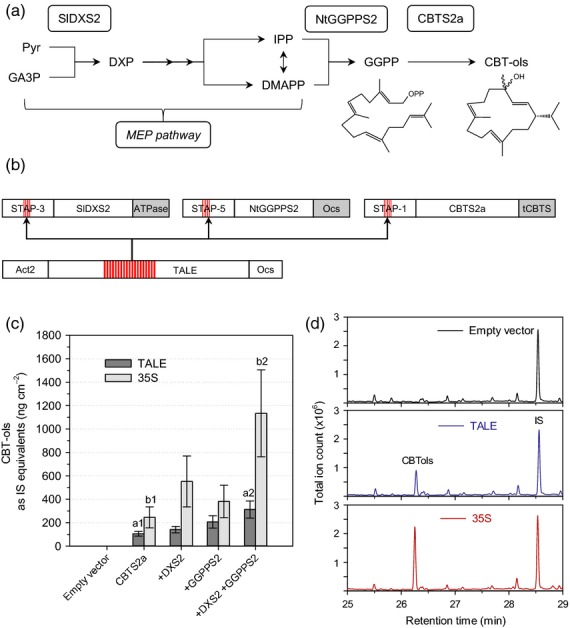Figure 4.

Using selected synthetic transcription activator-like effector-activated promoters (STAPs) for metabolic engineering of a plant diterpene.(a) overview of the pathway for cembratrienols (CBTols) including the methylerythritol-phosphate (MEP) pathway, highlighting the genes that were over-expressed in Nicotiana benthamiana. Pyr, pyruvate; GA3P, glyceraldehyde-3-phosphate; DXP, 1-deoxyxylulose 5-phosphate; IPP, isopentenyl diphosphate; DMAPP, dimethylallyl diphosphate; GGPP, geranylgeranyl diphosphate; SlDXS2, tomato 1-deoxyxylulose 5-phosphate synthase; NtGGPPS2, tobacco GGPP synthase; CBTS2a, tobacco cembratrienol synthase.(b) Overview of the constructs used for the overexpression of SlDXS2, NtGGPPS2 and CBTS2a using STAPs. The numbers of the STAPs correspond to the numbers in Figures2 and 3.(c) Comparison of transcription activator-like effector (TALE)-driven expression and p35S-driven expression in N. benthamiana leaves agro-infiltrated with p19 and CBTS2a,DXS2 and GGPPS2 in different combinations. Two leaves in three individual plants were infiltrated for each construct combination (n = 6). Mean amounts of CBTol are expressed as equivalents of the internal standard (IS, sclareol) ± SE. Groups indicated by different letters (a1/a2, and b1/b2) differ significantly from each other regarding their CBTol values (P < 0.05; Student’s t-test and two-way anova). No CBTol was detected in leaves expressing the empty T-DNA vector as a control.
